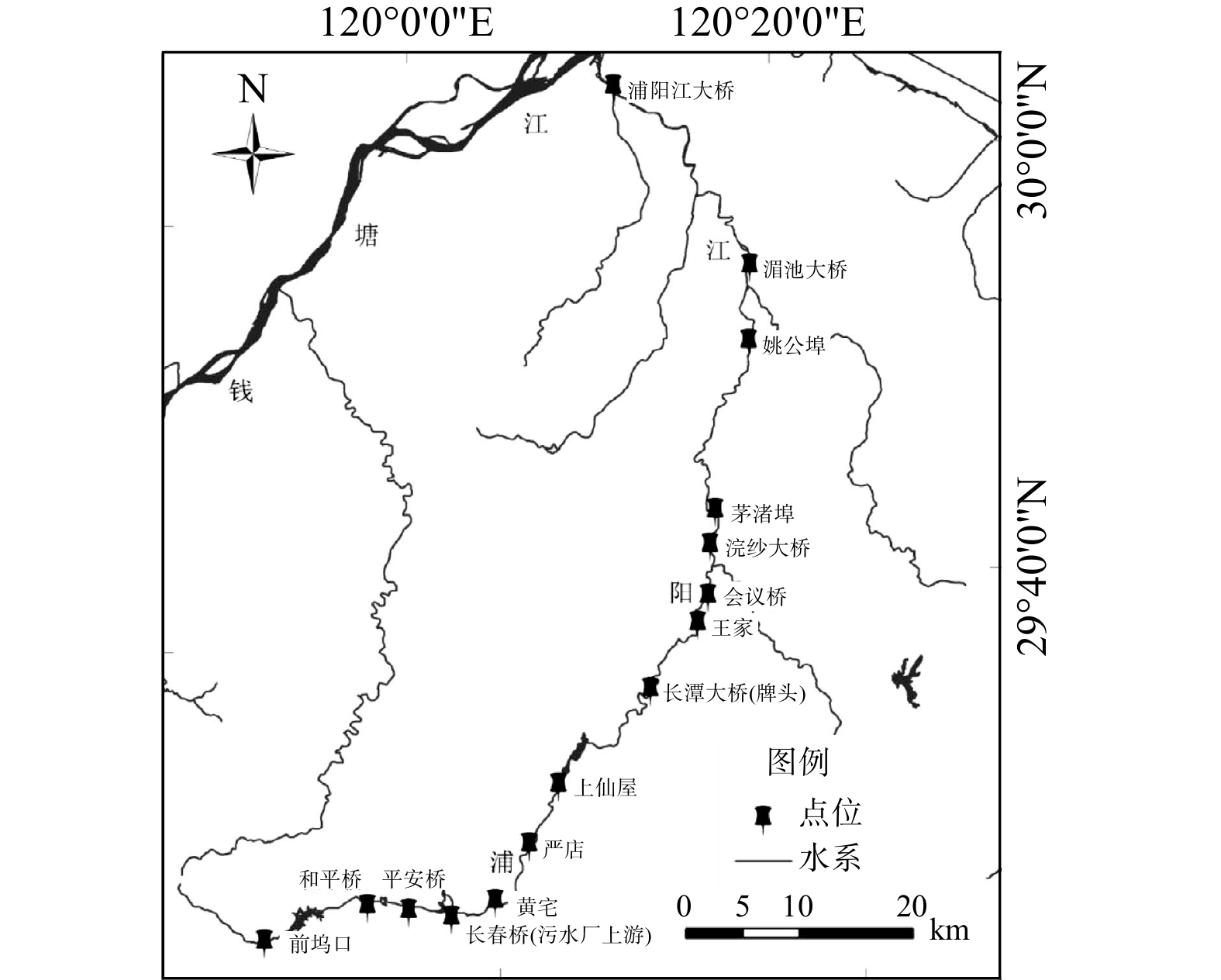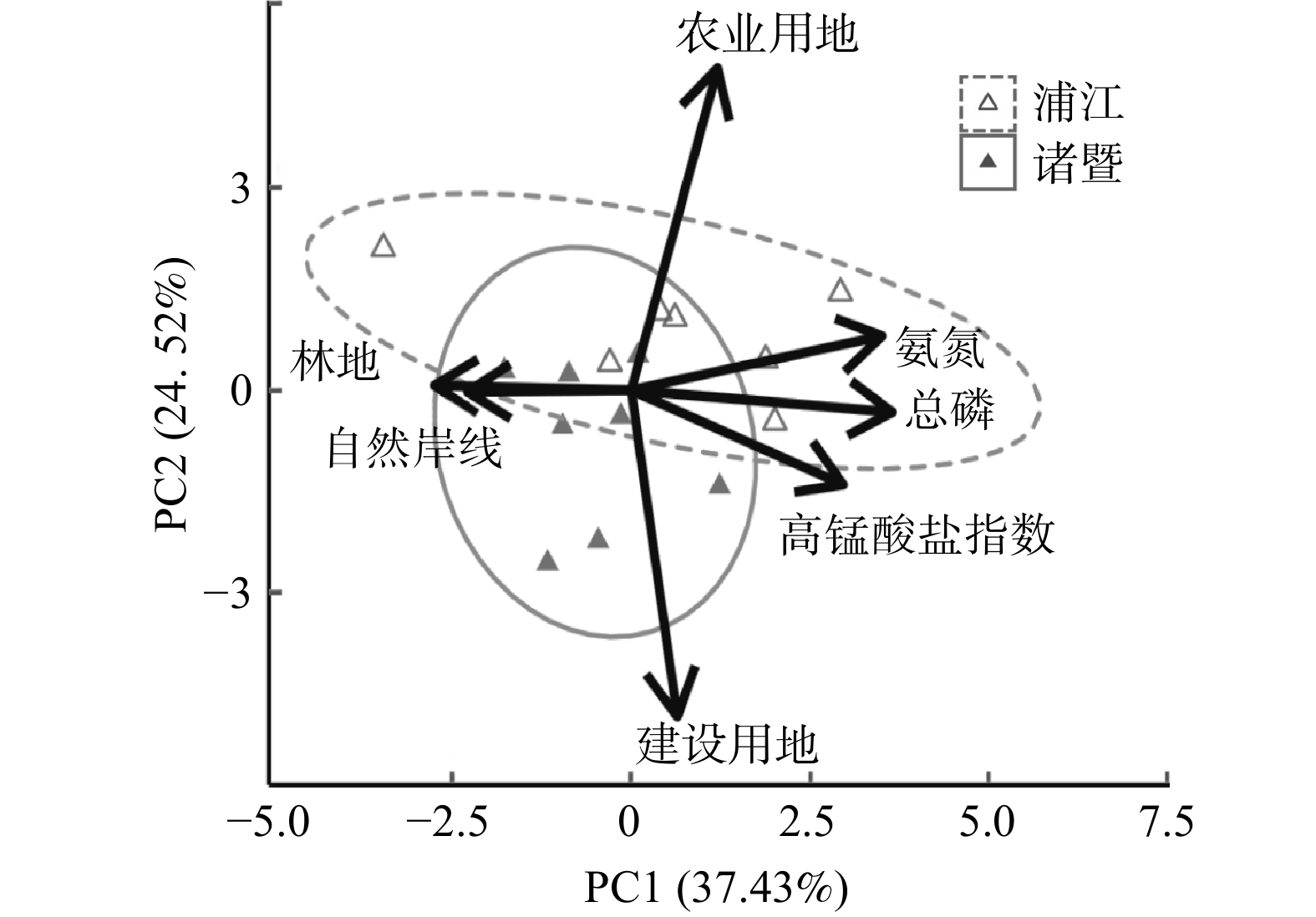-
河流生态缓冲带通常指为保护河流免于直接受到或减少人类活动干扰和自然干扰(如土壤侵蚀)的带状保护区域[1–3]。其中,人类活动包括城镇化、农业种植与养殖、工厂建设、道路建设、旅游、伐木等。河流生态缓冲带(简称“缓冲带”)中良好的土地利用类型,如林地或草地,是减轻陆地生态系统对河流生态环境干扰的重要屏障[4],也是降低面源污染对河流水生态质量影响的最佳管理实践(best management practices, BMPs)重要内容之一[5–7]。
人类活动会直接影响缓冲带土地利用类型的构成。与水质退化相关的土地利用类型主要为城镇建设用地和农业用地。而没有开发的土地利用类型,如林地,则有助于保护水质[8],且可以积极保护河流底栖动物[9]、鱼类[10]、软体动物[11]和龙虾等物种的多样性[12]。然而,关于缓冲带如何影响河流水质和水生生物,目前的认知并不全面。现有研究表明,除了受不同研究选择的空间尺度(区域尺度、流域尺度和沿岸带尺度)不一致的影响外[13],还与研究时选择的缓冲带宽度有关[14]。另外,缓冲带对河流水质和水生生物的影响在不同区域和不同河流间很可能存在差异[15]。因此,有关缓冲带对河流水质和水生生物影响的共性认识仍需更多来自不同河流的研究数据支撑。
本研究以浦阳江干流为研究对象,通过分析其干流缓冲带与河流水质和底栖动物多样性之间的关系,揭示缓冲带对河流水质和水生生物的影响机制,以期更好地发挥缓冲带的生态效应,并为科学合理地设计缓冲带提供参考。
-
本研究以浙江省浦阳江为研究对象,该河流为浙江省“五水共治”典型案例。浦阳江是钱塘江一级支流,发源于浦江县的天灵岩南麓,经浦江县流入诸暨市的安华水库,直至萧山闻家堰汇入钱塘江。浦阳江流域为亚热带季风气候,年均降水量为1 512.8 mm,其主干流长49.61 km,流域面积492.62 km2。
在浦阳江干流上共设置15个调查样点。其中,7个样点位于浦江县境内的安华水库上游(后称此河段称为“浦江段”),分别为前坞口、和平桥、平安桥、长春桥、黄宅、严店和上仙屋,河流水流速较快,基本为可涉水河段,底质组成以砾石、卵石为主;其余8个样点位于诸暨市内(后称此河段称为“诸暨段”),分别为长潭大桥、王家、会议桥、浣纱大桥、茅渚埠、姚公埠、湄池大桥、浦阳江大桥,河流水流速度较缓,都为不可涉水河段,底质组成以泥沙沉积物为主。浦阳江调查点位分布位置见图1。
-
野外采样于2019年5月进行。在浦江段和诸暨段内的每个样点采集600 mL水样,低温、避光保存带回实验室进行水质分析。分析方法严格参照《水和废水监测分析方法》[16]进行,测定高锰酸盐指数(CODMn)、氨氮(NH3-N)和总磷(TP)。
各样点的缓冲带数据由2019年GF1/GF2和ZY3影像数据解译获得,空间分辨率为8 m。缓冲带宽度为50 m,长度为以样点为起点,向上游延伸1 000 m。计算缓冲带内农田、林地和建设用地的占比情况。
应用多生境采样法,在每个点位的上下游各50 m范围内(即该采样点100 m河段)完成对底栖动物的采集。在每个河段内采集20个D型网样方,样方按照100 m河段生境类型(急流、缓流、不同水深、不同地质组成、水生植被等)的出现比例进行分配[17]。每个D型网(底边宽30 cm,60目孔径)的采集面积为0.09 m2,合计每个样点的总采样面积为1.8 m2。所有样方去除大石块和枯枝落叶,经40目孔径分样筛洗净后合成一个样本,保存在95%酒精或5%~8%的甲醛溶液中。在实验室中对每个样本的底栖动物进行挑拣、计数,并鉴定到尽可能低的分类单元,绝大多数物种鉴定到属或种,少数类群进行了较粗的分类鉴定(寡毛和涡虫到纲级,部分鞘翅目和全部半翅目到科级[18])。
-
选择大型底栖无脊椎动物群落的香农-维纳多样性指数(Shannon-Wiener)、物种丰富度和蜉蝣目(Ephemeroptera)+積翅目(Plecoptera)+毛翅目(Trichoptera)丰富度表征底栖动物群落物种多样性特征,其中Shanno-Wiener多样性指数(H' )按式(1)计算。
式中:ni为第i个分类单元个体数;N为样品中底栖动物总个体数。
采用Spearman相关性分析探究水质理化指标、缓冲带和底栖动物多样性指数间的相关性。为分析缓冲带对浦江段和诸暨段间的响应关系,进行了冗余分析(redundancy analysis,RDA),分析前先进行去趋势对应分析(detrended correspondence analysis,DCA)。若DCA结果中最大梯度长度大于4,则选择单峰模型CCA分析;若最大梯度小于3,则选择线性模型RDA;若梯度为3~4,则2个模型均可选择。利用主成分分析(principal component analysis,PCA)探究水质指标和缓冲带的空间分布格局。
基础统计分析在Excel中进行,其他所有分析均通过R语言(版本号4.0.2)ggplot2、ggord、ade4和vegan软件包进行。
-
通过对GF1/GF2和ZY3影像进行数据解译后发现:浦阳江上游浦江县的城市化发展程度较低,主要以农田为主(p<0.01),占比60.62%,其次是建设用地,占比23.02%;下游的诸暨市主要以建设用地为主(p<0.01),占比57.44%,其次是农业用地,占比21.49%;而林地,无论是在浦江段还是诸暨段都是最少,且两区域间无显著差别(如图2所示)。浦江上游主要以山地为主,土地肥沃、雨水充足适合耕种,所以上游缓冲带以农田为主。位于浦江下游的诸暨段以平原为主,整个诸暨市域内建设用地比例(12.5%)为浦江县建设用地比例(8.3%)的近1.5倍,沿浦江两岸建设用地相应高于浦江县。
-
根据《地表水环境质量标准》(GB 3838-2002)[19],浦江段和诸暨段区域内的水质指标CODMn、NH3-N和TP均处于同一类别。其中,CODMn和NH3-N均符合II类水质标准,TP符合I类水质标准,水质状况总体偏优(如图3(a)~(c)所示)。在浦江段共采集到底栖动物9 822头,在诸暨段共采集到2 496头,分别隶属于6纲16目89种。其中,水生昆虫物种多样性最高,共有64个分类单元(65.81%),其次为腹足纲(10个分类单元,5.80%)。从优势物种看,甲壳纲中的米虾(Caridina sp.)优势度最大,其次为四节蜉(Baetis sp.)和细蜉(Caenis sp.)。缓冲带以农田为主的浦江段中3个底栖动物多样性指数均显著高于以建设用地为主的诸暨段内的指数(如图3(d)~(f)所示)。
-
Spearman相关分析结果表明,氨氮和总磷与缓冲带的农田比例正相关、与林地负相关(如表1所示)。水质和缓冲带土地利用构成的降维分析表明(如表2所示):第一主成分(PC1)代表了样点的水质梯度,解释了38.21%的环境梯度变化;第二主成分(PC2)代表了缓冲带中林地和自然岸线梯度变化,贡献率为25.45%;第三主成分(PC3)代表了缓冲带受干扰程度,贡献率为22.85%。
15个采样点的主坐标分析(PCoA)表明(如图4所示),浦江段的7个样点中,有5个样点主要受水质和缓冲带中农田的影响,另外2个样点的缓冲带中的有较高的林地和自然岸线比例。诸暨段的6个样点缓冲带中的建设用地比例明显高于浦江段。上述Spearman和PCoA结果与前人研究结果一致,均表明水质与缓冲带中不同的土地利用类型间存在显著相关性[20-21]。而农业用地面源污染是造成水体氮、磷富营养化的主要原因[22]。TONG等[23]在美国俄亥俄州流域区域尺度上发现,氮、磷和电导率与农业用地呈显著正相关,而与林地呈显著负相关,这可能农业面源排放有关。
虽然建设用地导致水质恶化的报道很多[24-25],但本研究并未发现建设用地对水质退化有相关性。这可能与受试缓冲带中的建设用地均为道路,没有工厂用地和居民用地有很大关系,也与城镇污水收集管网和处理设施的完善有重要关系。缓冲带中林地与氮和磷之间的负相关关系(如表1所示)可能与现有报道认为的河岸带植被对氮和磷有较强的吸收作用有关,且吸收作用可能与缓冲带植被的宽度有很大关系[4,26-27]。有研究结果表明[22,28],缓冲带中20~30 m宽的植被缓冲带能有效拦截河流中40%~100%的氮,对磷的去除率在80%~85.07%。缓冲带对河流水质的改善作用与其宽度与长度有关[29]。LI等[14]发现宽度为300 m、长度为8 km的缓冲带是景观格局与水质之间联系最紧密的区域。加拿大和美国许多司法管辖区的缓冲带宽度标准为30 m,欧盟《水框架指令》规定缓冲带最小标准为20 m[30]。程昌锦等[22]认为除长度和宽度外,缓冲带的坡度、植被类型、植被密度、林龄和水土保持性能等均对水体污染物的截留有很大影响。
-
底栖动物数据的DCA结果显示,每个轴特征值的最大值为2.83(小于3),故选用冗余分析(RDA)。RDA前2个主轴可累计解释底栖动物群落组成变化的82.0%(如图5所示)。诸暨段底栖动物群落组成主要受自然岸线、林地和建设用地影响,指示性底栖动物为栉水虱(Asellus sp.)、石蛭(Erpobdella sp.)和小蟌(Agriocnemis sp.);而浦江段则主要受农田影响,指示性底栖动物为花翅蜉(Baetiella sp.)和等蜉(Isonychia sp.)。
AL-ZANKANA等[31] 对379个独立项目的研究发现,底栖动物的物种丰富度(27%)、多样性指数(18%)和EPT(6%)等指数常被用来评估河流的生态质量。浦阳江缓冲带中建设用地与底栖动物香农多样性指数、物种丰富度显著负相关,农业用地与底栖动物香农多样性指数、物种丰富度和EPT丰富度显著正相关(如表1所示)。
缓冲带中的建设用地和农业用地主要通过影响河流水质、水文和河道底质微生境质量等对河流底栖动物群落产生不利影响[32-33];林地则通过对污染物截留、提供倒木和凋落物等有机物、提高河流荫蔽度、降低河流水温等方式来促进和保护河流底栖动物多样性[34],以及河流食物链和食物网的稳定性、完整性[35-36]。本研究结果同样表明,缓冲带中建设用地对底栖动物有显著的负作用,而与大多数研究结果不同的是浦阳江缓冲带中农业用地与底栖动物有显著的正相关关系,林地并未表现出对底栖动物多样性恢复的有利作用。
以上结果的主要原因可能有3个方面。1)浦阳江上游即浦江段与中下游即诸暨段的缓冲带中主要土地利用类型完全不同。浦江段缓冲带以农业用地为主(60.62%),其次是建设用地(23.02%),诸暨段缓冲带以建设用地为主(57.44%),其次是农业用地(21.49%),而林地无论是浦江段还是诸暨段都是最少的,分别为16.29%和15.15%。WANG等[17]对钱塘江中游溪流的研究表明,当流域内建设用地比例超过3%~5%时,底栖动物多样性开始下降,并随着建设用地比例逐步升高,底栖动物多样性快速下降。因此,在现有缓冲带中建设用地比例高达40.23%的状况下,林地对底栖动物多样性保护的积极作用有限。2)浦阳江上游浦江段的底质组成以卵石、砾石等石材底质为主,泥沙含量少,适合底栖动物生长,而诸暨段水流较缓、水深较深等特点导致底质主要为泥沙。而底质异质性是影响底栖动物的重要因素之一[37-38],较高的河床泥沙含量会导致生境多样性降低、食物来源减少和生物栖息空间小且不稳定,从而导致底栖动物多样性降低[39]。因此,得益于河道内底质栖境的多样化,浦江段的底栖动物多样性显著高于诸暨段(如图3所示)。3)农业用地虽然是城市化程度较低流域的重要污染源,但在城市化程度较高的流域,农业用地的存在对水质改善有促进作用[8]。同样地,MOORE等[40]比较了美国马里兰州的城市和农业水源,发现农业水源的底栖动物多样性相对较高,这可能归功于该地区的免耕耕作和缓冲带等BMPs措施。通过使用BMPs来保护缓冲带已经被美国广泛应用于改善河流质量的管理实践[5–7]。浦江段缓冲带虽以农业用地为主,但林地比例略高于诸暨段,并且近6年来持续采取的生态修复措施在一定程度上提高了底栖动物多样性[41]。这些因素在一定程度上增强了农业用地与底栖动物多样性之间的相关性。
-
1) 河流生态缓冲带中农业用地和建设用地的增加是导致河流底栖动物多样性下降的重要的间接驱动因子。而在同一条河流的上下游,缓冲带中农业和建设用地对底栖动物多样性的影响有可能不同。
2) 缓冲带修复实践中,增加林地面积和自然岸线比例对河流水生生物多样性恢复与保护有促进作用。
浦阳江干流河流生态缓冲带土地利用类型对水质和底栖动物的影响
Effects of land uses within buffer zone on water quality and benthic macroinvertebrates in Puyangjiang River
-
摘要: 为揭示河流生态缓冲带土地利用变化对水质和水生生物多样性的影响,以浦阳江干流为研究对象,通过底栖动物野外采集、水质分析和河岸带土地利用解译,分析其干流河流生态缓冲带土地利用类型与河流水质和底栖动物多样性之间的关系。结果表明,高锰酸盐指数(CODMn)、氨氮(NH3-N)和总磷(TP)与林业用地呈负相关,但与农业用地显著正相关。底栖动物群落多样性与农业用地呈显著正相关,但与城镇用地显著负相关。冗余分析结果显示,浦阳江上游浦江段河流生态缓冲带中农业用地对底栖动物影响最大,中下游的诸暨段建设用地对底栖动物的影响最大。这表明同一条河流的上下游,河流生态缓冲带中农业和建设用地对底栖动物多样性的影响可能不同。河流生态缓冲带修复实践中,增加林地面积和自然岸线比例对河流水生生物多样性恢复与保护有促进作用。Abstract: In order to explore the effect of land use types on water quality and aquatic biodiversity in river ecological buffer zone, the main stream of Puyang river was taken as the research object by the field collection of benthic animals, water quaity analysis and riparian land use interpretation. The result showed that the permanganate index (CODMn), ammonia nitrogen (NH3-N) and total phosphorus (TP) were negatively correlated with the percentage of forest land use, while positively correlated with the percentage of agricultural land. The benthic community diversity was of positive correlation with the percentage of agricultural land and negative correlation with percentage of urban land. The redundancy analysis results revealed that the benthic animals were greatly affected by the percentage of agricultural land at Pujiang segment of the upper reaches of Puyang River, while the benthic animals were mostly affected by the percentage of urban land at Zhuji segment of the middle and lower reaches. It was showed that the agricultural land and urban lands may have different effects on the benthic animal diversity at the upstream and downstream within the same river buffer zone. It is suggested that the increase of wood land and natural bank ration would benefit the recovery and protection of river aquatic biodiversity in the restoration practice of river ecological buffer zone,
-
Key words:
- riparian zone /
- water quality /
- benthic macroinvertebrates /
- land use
-
表 1 水质因子、缓冲带和底栖动物的Spearman相关系数
Table 1. Spearman correlation among water quality, buffer zone and benthic animals
项目 CODMn NH3-N TP 农业用地 林地 建设用地 自然岸线 香农多样性指数 物种丰富度species 农田 0.08 0.41 0.38 林地 –0.07 –0.49 –0.47 –0.52* 建设用地 0.01 0.06 –0.05 –0.65** –0.29 自然岸线 0.04 –0.43 –0.15 –0.27 0.61* –0.24 香农多样性 0.16 0.18 0.36 0.70** –0.16 –0.63* 0.16 物种丰富度 0.25 0.22 0.24 0.75** –0.15 –0.67** 0.03 0.69** EPT丰富度 0.10 0.32 0.26 0.67** –0.39 –0.37 –0.02 0.58 0.82** 注:*表示在0.05水平上(双侧)显著相关;**表示在0.01水平上(双侧)显著相关。 表 2 水质指标和缓冲带土地利用组成的主成分分析
Table 2. The principle analysis of water quality and land uses in buffer zone
主成分梯度 CODMn贡献参数 NH3-N贡献参数 TP贡献参数 农田贡献参数 林地贡献参数 建设用地贡献参数 自然岸线贡献参数 λ 方差贡献率/% 累积方差贡献率/% PC1 0.918 0.642 0.92 0.122 –0.127 0.046 0.016 1.64 38.21 38.21 PC2 0.188 –0.498 –0.2 –0.301 0.929 –0.321 0.858 1.34 25.45 63.66 PC3 –0.091 0.282 0.068 0.916 0.058 –0.933 –0.019 1.27 22.85 86.51 注:第一主成分PC1代表样点的水质梯度,第二主成分PC2代表缓冲带中林地和自然岸线梯度变化,第三主成分PC3代表缓冲带受干扰程度;粗体表示在该主成分上的主要贡献参数。 -
[1] CORRELL D L. Principles of planning and establishment of buffer zones[J]. Ecological Engineering, 2005, 24(5): 433-439. doi: 10.1016/j.ecoleng.2005.01.007 [2] JUSYS T. Quantifying avoided deforestation in pará: Protected areas, buffer zones and edge effects[J]. Journal for Nature Conservation, 2016, 33: 10-17. doi: 10.1016/j.jnc.2016.05.001 [3] LOPES M S, VEETTIL B K, SALDANHA D L. Buffer zone delimitation of conservation units based on map algebra and ahp technique: A study from atlantic forest biome (Brazil)[J]. Biological Conservation, 2021, 253: 108905. doi: 10.1016/j.biocon.2020.108905 [4] KAVIAN A, SALEH I, HABIBNEJAD M, et al. Effectiveness of vegetative buffer strips at reducing runoff, soil erosion, and nitrate transport during degraded hillslope restoration in northern Iran[J]. Land Degradation and Development, 2018, 29(9): 3194-3203. doi: 10.1002/ldr.3051 [5] WARRINGTON B, AUST W, BARRETT S, et al. Forestry best management practices relationships with aquatic and riparian fauna: A review[J]. Forests, 2017, 8(9): 331. doi: 10.3390/f8090331 [6] GERGEL S E, TURNER M G, MILLER J R, et al. Landscape indicators of human impacts to riverine systems[J]. Landscape Indicators, 2002, 64: 11. [7] SHANDAS V, ALBERTI M. Exploring the role of vegetation fragmentation on aquatic conditions: Linking upland with riparian areas in puget sound lowland streams[J]. Landscape and Urban Planning, 2009, 90(1/2): 66-75. [8] TU J. Spatially varying relationships between land use and water quality across an urbanization gradient explored by geographically weighted regression[J]. Applied Geography, 2011, 31(1): 376-392. doi: 10.1016/j.apgeog.2010.08.001 [9] QUINN J M, BOOTHROYD I K G, SMITH B J. Riparian buffers mitigate effects of pine plantation logging on new zealand streams[J]. Forest Ecology and Management, 2004, 191(1/2/3): 129-146. [10] ALLAN J D, WIPFLI M S, CAOUETTE J P, et al. Influence of streamside vegetation on inputs of terrestrial invertebrates to salmonid food webs[J]. 2003, 60: 12. [11] POOLE K E, DOWNING J A. Relationship of declining mussel biodiversity to stream-reach and watershed characteristics in an agricultural landscape[J]. Journal of the North American Benthological Society, 2004, 23: 114-125. doi: 10.1899/0887-3593(2004)023<0114:RODMBT>2.0.CO;2 [12] ADAMS S B, DAVIS B A, MILLER D A. Hobbseus yalobushensis, a crayfish of intermittent streams: biotic and habitat associations, life history characteristics, and new localities[J]. The American Midland Naturalist, 2018, 179(1): 126-149. doi: 10.1674/0003-0031-179.1.126 [13] DING J, JIANG Y, LIU Q, et al. Influences of the land use pattern on water quality in low-order streams of the dongjiang river basin, China: A multi-scale analysis[J]. Science of the Total Environment, 2016, 551–552: 205–216. [14] LI K, CHI G, WANG L, et al. Identifying the critical riparian buffer zone with the strongest linkage between landscape characteristics and surface water quality[J]. Ecological Indicators, 2018, 93: 741-752. doi: 10.1016/j.ecolind.2018.05.030 [15] GRIFFITH J A. Geographic techniques and recent applications of remote sensing to landscape-water quality studies[J]. Water, Air, and Soil Pollution, 2002, 138(1/4): 181-197. doi: 10.1023/A:1015546915924 [16] 国家环境保护总局. 水和废水监测分析方法 [J]. 4版. 北京:中国环境科学出版社, 2002: 210-266. [17] WANG B, LIU D, LIU S, et al. Impacts of urbanization on stream habitats and macroinvertebrate communities in the tributaries of qiangtang river, China[J]. Hydrobiologia, 2012, 680(1): 39-51. doi: 10.1007/s10750-011-0899-6 [18] 浙江动物志委员会. 浙江动物志, 软体动物[M]. 杭州: 浙江科学技术出版社, 1991. [19] 国家环境保护总局, 国家质量监督检验检疫总局. 地表水环境质量标准: GB 3838-2002[S]. 北京: 中国标准出版社, 2002. [20] STUTTER M I, LANGAN S J, DEMARS B O L. River sediments provide a link between catchment pressures and ecological status in a mixed land use scottish river system[J]. Water Research, 2007, 41(12): 2803-2815. doi: 10.1016/j.watres.2007.03.006 [21] MEHAFFEY M H, NASH M S, WADE T G, et al. Linking land cover and water quality in new york city's water supply watersheds[J]. Environmental Monitoring and Assessment, 2005, 107(1/2/3): 29-44. doi: 10.1007/s10661-005-2018-5 [22] 程昌锦, 张建, 雷刚, 等. 湖北丹江口库区滨水植被缓冲带氮磷截留效应[J]. 林业科学, 2020, 56(9): 12-20. [23] TONG S T Y, CHEN W. Modeling the relationship between land use and surface water quality[J]. Journal of Environmental Management, 2002, 66(4): 377-393. [24] LEE S W, HWANG S J, LEE S B, et al. Landscape ecological approach to the relationships of land use patterns in watersheds to water quality characteristics[J]. Landscape and Urban Planning, 2009, 92(2): 80-89. doi: 10.1016/j.landurbplan.2009.02.008 [25] ALBERTI M, BOOTH D, HILL K, et al. The impact of urban patterns on aquatic ecosystems: An empirical analysis in puget lowland sub-basins[J]. Landscape and Urban Planning, 2007, 80(4): 345-361. doi: 10.1016/j.landurbplan.2006.08.001 [26] 李丽娟, 金文, 王博涵, 等. 太子河河岸带土地利用类型与硅藻群落结构的关系[J]. 环境科学研究, 2015, 28(11): 1662-1669. [27] 王琼, 范康飞, 范志平, 等. 河岸缓冲带对氮污染物削减作用研究进展[J]. 生态学杂志, 2020, 39(2): 665-677. [28] DHONDT K, BOECKX P, VERHOEST N E C, et al. Assessment of temporal and spatial variation of nitrate removal in riparian zones[J]. Environmental Monitoring and Assessment, 2006, 116(1/2/3): 197-215. doi: 10.1007/s10661-006-7403-1 [29] VIKMAN A, SARKKOLA S, KOIVUSALO H, et al. Nitrogen retention by peatland buffer areas at six forested catchments in southern and central finland[J]. Hydrobiologia, 2010, 641(1): 171-183. doi: 10.1007/s10750-009-0079-0 [30] LEE P, SMYTH C, BOUTIN S. Quantitative review of riparian buffer width guidelines from canada and the united states[J]. Journal of Environmental Management, 2004, 70(2): 165-180. [31] AL-ZANKANA A F A, MATHESON T, HARPER D M. How strong is the evidence: Based on macroinvertebrate community responses: That river restoration works?[J]. Ecohydrology & Hydrobiology, 2020, 20(2): 196-214. [32] IÑIGUEZ-ARMIJOS C, HAMPEL H, BREUER L. Land-use effects on structural and functional composition of benthic and leaf-associated macroinvertebrates in four andean streams[J]. Aquatic Ecology, 2018, 52(1): 77-92. doi: 10.1007/s10452-017-9646-z [33] 马凯, 张海萍, 渠晓东, 等. 滦河流域土地利用对大型底栖动物生物指数的路径分析[J]. 中国环境科学, 2017, 37(7): 2674-2683. doi: 10.3969/j.issn.1000-6923.2017.07.032 [34] ALLAN J D. Landscapes and riverscapes: The influence of land use on stream ecosystems[J]. Annual Review of Ecology, Evolution, and Systematics, 2004, 35(1): 257-284. doi: 10.1146/annurev.ecolsys.35.120202.110122 [35] HERMAN M R, NEJADHASHEMI A P. A review of macroinvertebrate- and fish-based stream health indices[J]. Ecohydrology & Hydrobiology, 2015, 15(2): 53-67. [36] KOPERSKI P. Diversity of freshwater macrobenthos and its use in biological assessment: A critical review of current applications[J]. Environmental Reviews, 2011, 19(1): 16-31. [37] 张又, 刘凌, 蔡永久, 等. 太湖流域河流及溪流大型底栖动物群落结构及影响因素[J]. 中国环境科学, 2015, 35(5): 1535-1546. doi: 10.3969/j.issn.1000-6923.2015.05.034 [38] 王皓冉, 陈永灿, 刘昭伟, 等. 牡丹江中游底栖动物分布及其与栖境因子的关系[J]. 中国环境科学, 2015, 35(4): 1197-1204. [39] SUNDERMANN A, ANTONS C, CRON N, et al. Hydromorphological restoration of running waters: Effects on benthic invertebrate assemblages: Benthic invertebrate response to restoration[J]. Freshwater Biology, 2011, 56(8): 1689-1702. doi: 10.1111/j.1365-2427.2011.02599.x [40] MOORE A A, PALMER M A. Invertebrate biodiversity in agricultural and urban headwater streams: Implications for conservation and management[J]. Ecological Applications, 2005, 15(4): 1169-1177. doi: 10.1890/04-1484 [41] 盛天进, EVANCE M, 吴聪, 等. 浙江浦阳江大型底栖无脊椎动物物种多样性和生态功能恢复研究[J]. 环境监控与预警, 2021, 13(2): 1-8. -





 下载:
下载:





